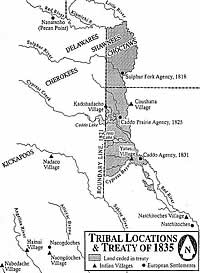
Tribal Locations and Treaty of 1835,
From The Caddo Indians: Tribes at the Convergence
of Empires, 1542-1854, F. Todd Smith, 1995, courtesy
of the author.
Click images to enlarge
|
|
Some Caddo voices are quiet like a whisper.
Some ring out like a bell calling workers in from the field.
Some say, "Those people who said those things, they did not
know." Some say, "those people who said those things—maybe
they were true—maybe not. does not seem right."
Caddo lands in Louisiana
were ceded by treaty between the Caddo and the United States
in 1835. The treaty required the Caddos to leave the boundaries
of the United States within a year. At that time Caddos were
living on the west end of a lake they called T'soto, later
known as Caddo Lake. Their name for the place was Sha'chahdíinni,
"Timber
Hill." On leaving Sha'chahdíinni, the Red
River Caddos of Louisiana were twenty years without a home.
Texas seemed a safe place for Caddos to resettle,
build new homes, plant new crops, and nurture children. East
Texas was the ancestral homeland of their kindred, the Hasinai
("Our People"). Generation after generation of Caddos
wore major footpaths through the east Texas black land prairie
on their way to hunt, camp, meet and trade. An east-west path
led to favored camp sites in present Tarrant County. A north-south
trail, the Caddo Trace, crossed the northeast corner of what
is now Dallas County. There were no roads. North central Texas
still belonged to Indians when Principal Caddo chief, Tarshar,
led approximately three quarters of the Caddos to the western
fringe of Hasinai traditional hunting ground in 1836.
|
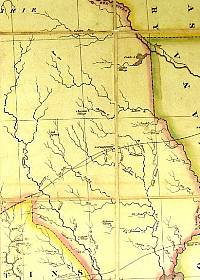
East Texas as depicted on Stephen
F. Austin's 1830 map. Texas seemed a safe place for
Caddos to resettle (in 1835), build new homes, plant
new crops, and nurture children. East Texas was the
ancestral homeland of their kindred, the Hasinai ("Our
People").
|
|
|
| |
Estimated Population of Texas in
1836
Estimated Population of Texas in September,
1836:
Anglo-Americans 30,000
Mexicans 3,470
Indians 14,200
to which add the civilized tribes—Cherokees, Kickapoos,
Choctaws, Chickasaws, Potawatamies, Delawares, and Shawnees—8,000
Morfit to Forsyth, August 27, 1836
|
|
|
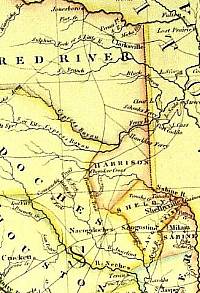
1841 Arrowsmith map of Texas showing
east Texas. Notice the trails through Nacogdoches. Trammel's
Trail leading north is part of the old north-south Caddo
Trace, now being used by Anglo settlers pushing into
Texas from Arkansas. Click to see enlarged view and
overview of map.
|
|
Hasinai villages, like
Caddo communities, suffered a great loss of place and population
before 1835. Immigrant Indian bands as well as white people
crowded into the east Texas territory once dominated by Hasinai.
Only Hainai and Nadako, two of the old Hasinai locations,
remained in 1835. Written documents from this time forward
refer to the people of those villages as "Ioni"
and "Anadarko".
When Sam Houston became
President of the Republic of Texas, he sent commissioners
to make a treaty with the Hainai and Nadako. A resolution
"that the Senate advise and consent to ratification of
a treaty entered into between T J Rusk and K H Douglass on
the Part of the Republic of Texas and the Chiefs of the Ioni
and Anadarko Tribes of indians on the 21 day of August 1837"
was submitted to the Texas Senate in October, 1837. The treaty
was lost at some unknown time. Not even a copy can be found
in the great volume of Texas Indian Affairs records, correspondence,
and treaties that are carefully preserved from early days
of the Revolution to present.
|
|
|
| |
Grandmother's story:
well, the way grandmother's sister,
she's the one who really told some of the stories about that.
She was much older than my grandma was. She must of been about
eight or ten years older than my grandmother was. . . . And
my grandmother, her mother, they put her on a horse with my
grandmother and her sister. . . .her mother turned around
to go back cause she knew that the way things was going turning
out they was going to starve to death or die or somebody seeing
dying on the way. That she wanted to go back to Louisiana,
if she was going to die she wanted to die back home. And she
kinda rebelled against em, and she was killed. My aunt said
that soldiers stuck her with a knife. Is what she said. She
was on this horse and she said her mother fell off the horse.
She was telling about that's when they moved.
Fallis Elkins, 1973
|
|
|
| |
Conflict
Treaties did not prevent whites from taking
Indian land in east Texas. Surveyors swarmed valleys of the
Neches and Angelina streams where the Hasinai had lived for
centuries. New white settlers surrounded the Anadarko and
Hainai villages and pressed against the settlements of other
Indians who had emigrated and settled there first. Caddos
quickly learned; whenever men with sticks and chains appeared,
white settlers soon followed. Conflict was inevitable. Hainais
and Anadarkos fled from violence, moving west to the Three
Forks of the Trinity River where Caddos kindred from Louisiana
were trying to establish new homes.
|
|
|
| |
"Mistaken for renegades":
There was so many different communities
that the word "nah" . . . denoting "from"
"those" "they" "them" "of"
. . . Nah-shu-tush "It's a community that they lived
in . . .I think there were about seven bands altogether .
. . . the Ha-si-nai, Ka-doha-da-cho, Hai-Nai- Hai-ish, Ya-ta-si,
they were often mistaken for the renegades of other tribes
. . . . several were—as I say, mistaken for renegades
when they were out hunting, that's where most of the murders
were committed . . . .
Sadie Bedoka Weller, 1968.
|
|
|
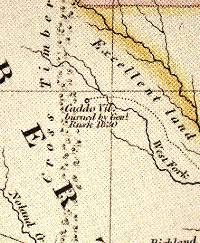
Detail from 1841 Arrowsmith map in
Robertson County reads "Caddo Village burned by
Genl Rusk 1839"
|
|
Caddos crossing from Louisiana into Texas roused
suspicion and animosity. Texas Declaration of Independence
was only month's old. Many Anglo Americans greedy for free
land in Texas brought anti-Indian sentiments with them. Almost
all were gripped by fear that Caddos from Louisiana intended
to lead massive attacks plotted by Mexicans. Tarshar and other
Caddo chiefs admitted that Mexican agents had been among their
people but denied that the Mexicans were given Caddo loyalty.
Still rumors were rampant. Caddos were accused of instigating
or joining in frontier attacks made by roving groups of plains
Indians.
Texans petitioned United States officials to
keep Caddos in Louisiana, at least until the war was over.
General Thomas J. Rusk went a step farther in November 1838.
Riding at the head of seventy men he invaded the United States
to take control of Caddos living well inside Louisiana, about
twelve miles from Shreveport. The Caddos were disarmed, their
meager arsenal deposited with their agent in Shreveport. Rusk
demanded they stay there until the war with Caddos on the
Texas frontier ended. After making this "treaty"
with the Caddos in Shreveport, Rusk joined a campaign against
Caddos on the Trinity River. He found and burned their village
in the Cross Timbers west of the Trinity in January 1839.
Texas Rangers, mostly local community volunteers
organized to protect the frontier from Indians, became progressively
diligent in their search for and destruction of Caddo villages.
Accounts of Indian fights are many and various. Told and retold,
some like the "Battle of Village Creek", have become
part of Texas folklore. The report written by Acting Brigade
Inspector Wlliam N. Porter on June 5, 1841, may be an accurate
account of the running battle that took place May 24, 1841.
|
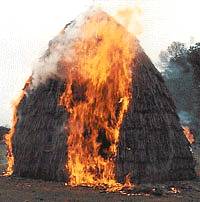
A grass-thatched Caddo-style house
blazing less than a minute after the fire was set. The
scene eerily recreates the cold day in January, 1839
when General Thomas J. Rusk torched a Caddo village,
not long after making a "treaty" with the
Caddos. Photo by Velicia R. Bergstrom.
|
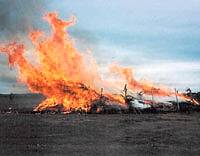
Within five minutes the house collapses.
Five minutes between home and embers. Photo by Velicia
R. Bergstrom.
|
|
|
| |
Battle of Village Creek:
We soon found two villages, which we found to be deserted-the
Indians at some previous time, had cultivated corn at these
villages. There were some sixty or seventy lodges in these
two villages. They were on the main branch of the Trinity.
. . . General Tarrant deemed it imprudent to burn these villages,
for fear of giving alarm to the Indians. . . but they were,
in a great measure, destroyed with our axes. . . . On the
24th . . . . we found very fresh signs of Indians—The
spies were sent ahead, and returned and reported the Indian
Villages in three miles. We arrived in 3 or 4 hundred miles
yards, and took up a position behind a thicket. . . . the
line was formed, and the word given to charge into the Village
on horseback; and it was taken in an instant, the Indians
scarcely having time to leave their lodges before we were
in the Village; several were shot in attempting to make their
escape. Discovering a larger trail leading down the creek,
and some of the Indians having gone in that direction, a few
men were left at that Village and the rest at full speed took
their course down the creek, upon which the Village was situated.
Two miles from the first Village,
we burst suddenly upon another Village, this was taken like
the first—There was another in sight below—many
of the houses having fusiles, the men race toward this Village
on foot; but the Indians having heard the firing at the second
Village, had time to take off their Guns and ammunitions,
and commenced occasionally to return our fire. From this time
there was no distinction of Villages, but one continued Village
for the distance of one Mile and a half, only seperated [sic]
by the creek upon which it was situated.
We had now become so scattered—Genl.
Tarrant deemed it advisable to establish some rallying point
to which smaller parties should be expected to rally—We
marched back to the second Village, . . .General chose this
as the position—From this point Capt Jno. B. Denton,
aid to Genl. Tarrant, and Capt. Bourland took each ten men
for the purpose of scouring the woods. The parties went different
directions, but formed a junction one mile and a half below
the said Village . . .discovering a very large trail—much
larger than any we had seen, . . . perceiving though the timber
what appeared to be a village still more large than any they
had heretofore seen, but just as the head of the two detachments
were on the end of entering the creek, they were fired on
from every direction by an enemy that could not be seen. .
. . In this situation the men did the best they could . .
. making every demonstration, as though they intended to charge
the creek. The Indian yells and firing soon ceased, and both
parties left the ground. It was not the wish of General Tarrant
to take away Prisoners. The women and children, except one,
escaped as they wished, and the men neither asked, gave, or
received any quarter.
From the Prisoners who we had taken,
we learned that at these Villages there were upwards of one
thousand warriors, not more than half of whom were then at
home, the other half were hunting Buffalo, and stealing on
the Frontier.
William N. Porter, Acting
Brigade Inspector, "Report of the Brig. General Tarrant's
Expedition against the Indians on the Trinity"
Original in Texas State
Archives, Austin
|
|
|
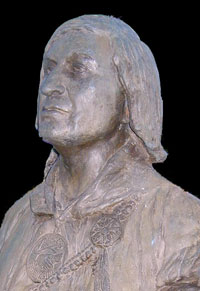
Jose Maria, Caddo name Iesh, was
the leader of the Caddos, Hainais, and Anadarkos in
Texas. He was esteemed by both white men and Indians.
This sculpted bust of Iesh stands in the National Hall
of Fame for Famous American Indians, Anadarko, Oklahoma
|
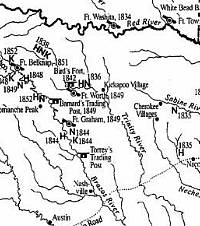
Caddo Tribal Locations 1835-1854,
From The Caddo Indians: Tribes at the Convergence
of Empires, 1542-1854, F. Todd Smith, 1995, courtesy
of the author.
|
|
According to Porter, who was there when the
battle was fought, General Edward H. Tarrant organized a company
of 67or 69 volunteers who left Fort Johnson (an small fort
in present Grayson County). Five days later they found two
deserted villages on the western branch of the Trinity River.
After another five days they found the first of four occupied
villages, about two miles or less from another. They charged
the first on horseback and took it easily. The second was
taken just as easily. Indians in the third village, though,
heard the gunfire from the second and fled. The fourth village,
larger than the others, was seen only through the trees. The
Indians there had time to prepare. As Tarrant's men came near,
they were met with gunfire coming from every direction. One
Texan was killed, two wounded. Convinced they were outnumbered,
they picked up their bounty from the first three villages
and headed back to the white settlements.
A count of twelve dead Indians was claimed by
the Texans but, because of the great amount of blood seen
on their trails, they thought more were killed or wounded.
Not counting the fourth village seen only through the trees,
Porter reported 225 lodges and about 300 acres of corn in
the villages.
When a larger force of Texans returned in July,
they found the villages empty and burned the dwellings. Caddos,
Hainais, and Anadarkos had lived there, along the present
Fort Worth/Arlington boundary. With them were fragmentary
groups of Cherokees, Creeks, Seminoles, Wacos, and Kickapoos.
Later that summer, Bird's Fort was built near the battle site.
It was occupied for only a few months but remained in use
as a frontier gathering place.
The Caddo chief who led Caddos into Texas, was
killed in early 1840. His name is spelled Tarshar in most
documents of the period, but is given as "Wolf"
in some. Since the Caddo name for wolf is ta'-sha, that is
probably the correct name of the Caddo chief. After Ta'-sha's/Tarshar's
death, José Maria rose to be the principal leader of
the Caddos, Hainais, and Anadarkos. Esteemed by both white
men and Indians, he gained an almost legendary status during
the turbulent years that followed.
Let Us Live Together in Peace: Councils, Treaties, and Promise
of Peace 1843-1846
The unwavering desire of Caddos, Hainais, and
Anadarkos was to have a peaceful, permanent, place to call
home. Without hesitation, they attended peace councils, signed
treaties, and staunchly kept the terms. Principal chief José
Maria and Caddo chiefs Bintah, Chowa and Ha-da-bah met with
Commissioners for the Republic of Texas in March 1843. The
meeting was on Tehaucana Creek at a placed used for intertribal
councils long before Americans arrived in Texas. Chiefs and
headmen of the Delaware, Shawnee, and the so called "wild"
tribes, Tawakoni, Waco, Wichita, and Keechi, were also represented
at the Council. The Commissioner appointed by President Sam
Houston addressed the Council:
|
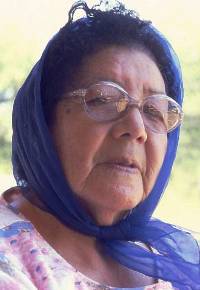
Lillie Whitehorn, granddaughter of
Jose Maria 1978, had this to say about her grandfather:
"He's got a pretty name and I do not know why they
use that Jose Maria-I do not like it. They should use
his Indian name Caddi Ha-Iesh." 1973 photo by Cecile
Carter.
|
| |
| |
| |
| |
|
|
| |
The President of Texas has heard
that our brothers, the red men, want to make peace with us:
for this purpose he has sent us, his Commissioners to meet
you. . . .You have heard the talk of our President read to
you. He is the friend of the red man; he always has been their
friend: he does not talk to them with a forked tongue. He
tells you to listen to the words of the Commissioners. We
will not deceive you, or give you a crooked Talk.
General G. W. Terrell,
Commissioner in behalf of the Republic of Texas
|
|
|
| |
This "Talk" offered promises the "red
men" longed to see fulfilled: a country to live in, in
Texas; trading houses in their country; agents to live among
them and always send their talks to the President, carry his
talks back to them, and see that white people did not intrude
upon them. Indians could trade at Torrey's Trading House on
the Brazos River without being harmed by Texas citizens. They
could plant corn any place north of the Trading House that
was built near the mouth of Tehuacana Creek about four miles
from the old Council ground.
|
|
|
| |
Bintah, spoke for the Caddos saying:
. . . I have only one thought in my heart,
I have heard your talk and hold fast to it, your talk is good.
. . . What I say to day I shall say always. If I should awake
in the middle of the night, I still think the same as now,
and I will be true all the time. Our women and children will
now be without fear, the road is cleared, for them to travel
without danger, I believe that what you have told me is truth,
and that from this time henceforth we are all friends----"
|
|
|
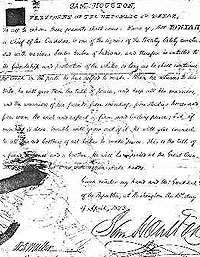
President Houston's certificates
recognizing Bintah & José Maria.
|
| |
| |
| |
| |
|
Following the council at Tehaucana Creek, Bintah
and José Maria were invited to visit President Sam
Houston at the Texas Capital. Eighty-five years later, the
widow of another Caddo Chief, Whitebread, turned two carefully
preserved documents over to the tribal attorney. (The documents
are archived in the Oklahoma Museum of History.) Except for
the names, Bintah chief of the Caddo and José Maria
chief of the Anadarko, they were identical. The great seal
of the Republic of Texas was set on white, blue, and green
ribbons that Houston said denoted peace, the sky, the grass
and trees, existing as long as the world stands.
Treaty at Bird's Fort 1843
A Grand Council to conclude a "Treaty of
Peace and Friendship" was scheduled to meet August 10,
1843 at Bird's Fort. President Houston was present on the
set date. He waited a disappointing month for the Comanches
to arrive before going back to the Texas capitol. The Comanches
never came but Commissioners and the chiefs of nine tribes--again
including Caddo, Anadarko, and Hainai, signed a treaty that
incorporated the principals of Houston's peace policy on September
29, 1843. Commissioners were careful not to include
recognition of the Indians rights to possess Texas land. The
Treaty at Bird's Fort is a rarity. It is one of the few treaties
ratified by the Republic of Texas Senate.
1844 Council
Although chiefs of nine tribes signed the Bird's
Fort Treaty, errant bands continued raiding and stealing horses.
When pursued, they frequently passed through the Anadarko,
Caddo and Hainai villages on trails that led from white settlements
to the villages of different Wichita bands. They were thoroughly
rebuked by Caddo chiefs at a council meeting on the Tawakoni
Creek grounds in 1844.
|
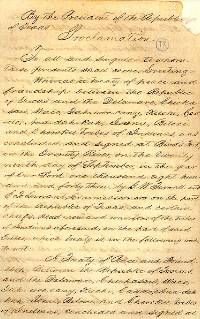
Bird's Fort Treaty Ratification Proclamation,
1843. The 1843 Treaty at Bird's Fort is one of the few
treaties ratified by the Republic of Texas Senate. Texas
State Library & Archives Commission Archives &
Manuscripts "Indian Relations."
|
| |
| |
| |
| |
|
|
| |
Caddo Chief Red Bear:
I do not like to see guns firing and blood
spilled, for I am a friend of peace. I am one of the oldest
of my tribe. All the red men and all of my other brothers
know me well: they know I want to travel on in the white road.
. . .my hands are clean and I like to see others the same.
. . .I live upon the Brazos. José Maria the Anadarko
chief is my neighbor, when our brothers steal horses and take
them through our towns the whites blame us for it. . . .
Caddo Chief Ha-de-bah:
. . .You have heard what the old chiefs
have said: I want you now to hear me, a young man speak. .
. .I want you to hold strong to their talk. We are not talking
here to children: our talk is strong and we all want you to
hear it. Your warriors by living as we would wish them to,
would be happy, and your wives and children see no danger.
Captains and you, young warriors, I want you all to stop going
to war: 'tis all I have to say to you.
José Maria seldom spoke in the
earlier councils. This time, while holding a string of wampum
beads, he took his turn saying:
As I am myself, small in size, my words
to fit me, shall be few. long talks admit of lies; my talk
shall be short but true. Captains and chiefs, listen to me.
The Great Spirit has given to us a good day, and we have listened
to many good talks. Captains I want you now to listen unto
me. the Big Spirit, above, is watching all now here. young
men you all look happy. Captains, if you love your children
advise them not bad, but good; and show to them the white
path. . . .The Great Spirit our father and our mother, the
earth sees and hears all we say in council. You have listened
to good talk. I hold the white path in my hands given to me
by our white brothers. look at it: see it is all fair. To
you, Waco and Tawakoni captains and warriors, I give it. stop
going to war with the white people. they, the white people,
gave it unto me: I give it now to you: use it as I have done
and your women, and children will be happy, and sleep free
of danger. I give to you this piece of tobacco to smoke, and
consider of the white path. when you return to your village,
then smoke this tobacco, think of my words and obey them.
|
|
|
| |
The straight talk of the chiefs had no lasting
effect on the young men of the Waco, Kichai, and Tawakoni.
By the Fall season, Red Bear felt it was time to take charge
and punish the culprits. He sent messengers to José
Maria's village to raise men for war against the Waco. The
warriors intended to go to the white settlements and ask the
Texans to join with them against the Wacos or, if they did not
want to fight, they would be asked to witness the punishment
of the Wacos. The messengers were persuaded to wait at José
Maria's village until the next council scheduled for October.
1844 Tehuacana Creek Treaty
President Houston was present at the next Council
held in October, the first attended by Comanches. A treaty
much like that made a Bird's Fort was concluded and presents
were distributed to all but the Wacos who were told they could
not receive theirs until they brought in the stolen horses.
Wild talk and rumors of whites' deceit began
to spread throughout the Indian villages. Perceiving a danger
in rising unrest caused José Maria to present the longest
talk ever recorded for him. Honoring his treaty commitment,
he reported to the Indian agents at Torrey's Trading house
in January 1845:
|
|
|
| |
My young men have left me and gone around
because they have heard bad talk, but I do not believe this
bad talk, and this is the reason I wish to hold council. That
my young men may be convinced that the talk they have heard
is false and the talk of bad men.
When I went out on my hunt, I got a passport
from the agent, and did not meet any trouble until I got nearly
back to this place. When I met this bad news.
When Col. Williams [an Indian agent]
went up into our country last summer, I was told that the
object of his mission was to get all the women and children
in to the council in the fall, and that the whites were then
to fall upon them and kill them. The waggons with the goods
were to stop below and the troops from the United States were
to assist in killing them. At the last Council all of the
Captains said the old men with grey beards would not tell
lies.--My beard is not yet grey: I am a young man, but I speak
truth. For myself I believe that these stories I have heard
are lies. . . .For my own part I am not afraid, but my people
say I am a fool for staying so near the whites, as so soon
as the corn gets fit to eat they intend to raise and kill
them all and that the reason these goods were put here was
to cheat our people out of their hunts to pay for the good
white men they have killed.
I have understood also that if we did not
go with the whites and help kill the Waco that the whites
would think we were friends to the Waco, and kill us.--The
Waco say that if we do not move out, away from the whites
they will steal our horses, so you see we are between two
fires. What shall we do? I know that it is the desire of the
whites to make peace with all, but it is impossible. The whites
have done their best to make peace, but the Waco and others
will not be friends.
Two nights ago news was brought me that
the Waco had stolen all the horses from 5 of my men, and that
the men had left their families and pursued the Waco, and
I have not heard of them since and do not know whether they
are killed or not.
The Waco also stole some horses from some
Lipan a short time since. . . .They have also stolen all the
horses from Bintah's son, and he has followed them. . . .I
come in to see you and give you my talk so that it can be
sent to your Chief as I do not wish to go around like my young
men have done but come straight to the white path, and pursue
it. Our women and children are naturally scary; but myself
and men are not afraid.
Brothers my talk is done.
Jose Maria
|
|
|
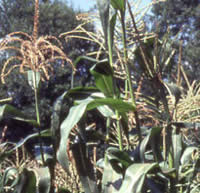
"José Maria and his people
had about 150 acres of some of the finest corn ever seen in
Texas. Their gardens were green with plump watermelons, beans,
peas, and pumpkins yellowed on vines." Photo by Frank
Schambach of Arkansas corn field.
|
José Maria and his people had about 150
acres of some of the finest corn ever seen in Texas. Their
gardens were green with plump watermelons, beans, peas, and
pumpkins yellowed on vines. In the general council held at
the Tehuacana Creek grounds that fall, he and Bintah spoke
once more of their hope that the white path would be kept.
Towaash, chief of the Hainai, told the council:
|
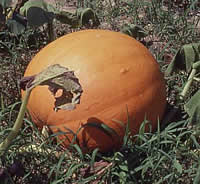
Pumpkins were one of the favorite crops of the Caddos. Photo
by Frank Schambach. |
|
| |
The President thinks now that all his people
are not afraid, . . . because his women and children know
that all is peace. Our women and children are not afraid now
of the white warriors, all is good. . . .I know what I promised
at the first Treaty, and I have done as I said. The President
then gave us powder and Lead, and told us to go home and shoot
deer and buffalo, and raise corn, for our women and children,
so that in the cold rainy weather they would not cry for bread
and meat. We have done so and found that it is good. All that
he told us was true, and now I can go home to my people and
tell them that all is still good, that they can eat and sleep
in safety and feel no more afraid.
|
|
|
| |
The Caddos who made the long journey from Louisiana
to Indian Territory had not endured conflicts with white men.
They were, however, as homeless in Indian Territory as their
kinsmen in Texas. Forced to depend almost entirely on hunting
to feed their families, they somehow managed to maintain dignity
while struggling to support their families in midst of conflicts
between immigrant tribes moved to the Territory by the treaties
with the United States and prairie tribes reluctant to give
up their historic hunting range.
The Creek Indian Nation attempted to bring peace
by hosting a intertribal council near the present town of
Eufaula, Oklahoma in 1845. Eight Caddo chiefs were among those
attending. Cherokee Indian Agent, Pierce M. Butler, noted
his impression of the Caddo spokesman, Chowawhana:
|
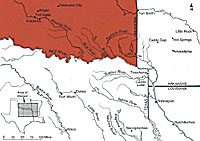
The Caddos who made the long journey from
Louisiana to Indian Territory followed the course of the Red
River. From Carter, 1995, Caddo Indians: Where We Come
From, courtesy of the author.
|
|
| |
The talk of the Caddo chief was of
deep interest. He was a striking man of great personal beauty
and commanding appearance. Small in stature, yet beautiful
and attractive features, dressed in what would be called Indian
magnificence, feathers, turbans, and silver bands. His speech
was looked for with interest and was very well received. Approving
the council, deploring the past and probable future fate of
the red man, had been gloomy, future prospects worse, hostility
among themselves, destruction of their race and ruin of their
children. His people honest and true to the objects of this
council. Would, when he got home assemble the people and tell
them the talk. The same as though they were present. . . .Creek
chiefs made long speeches in good taste and temper promising
peace and good will to the effect that their brothers the
Caddos had agreed to become the messengers of this tobacco
and beads to the Comanches and the Osages to take it to the
Pawnee Mohaws wish them to spread the news wherever they went.
notes taken at the "Grand
Council" by Cherokee Agent Pierce M. Butler
|
|
|
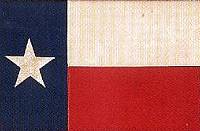
In 1846 the Lone Star flag of the Republic
was lowered and the flag of the United States raised in State
of Texas.
|
Texas Statehood and US Treaties
Peaceful relations between tribes and Texans
were still tenuous when Texas was annexed to the United States
in 1846. As a state, Texas reserved rights to all public lands,
assumed no further responsibility for Indians, and charged
the federal government with the right and duty to defend the
state's frontiers. In other words, the United States had political
control of the Indians, but the state controlled the land
they lived on.
The United States lost no time in negotiating
a treaty with the Texas Indians. The circumstances were odd.
Indian signatures (marks by their name) were collected on
a separate sheet of paper but were not identified by tribe
and the treaty between "commissioners on the part of
the United States" and the "undersigned chiefs,
counsellors and warriors of the Comanche, I-on-i, Ana-da-ca,
Cadoe, Lepan, Long-wha, Keechy, Tah-wa-carro, Wi-chita, and
Wacoe tribes of Indians, and their associate bands" was
actually not written until after the commissioner returned
to Washington D.C.
|

1846 United States Flag (28 stars).
|
|
| |
KNOW ALL MEN BY THESE PRESENTS that Jose
Maria a chief of the Ano-ddah-kos and the tribe to which he
belongs are by Treaty, on terms of Peace and Friendship with
the United States of American.
Jose Maria has in person visited Washington
City, the seat of Government of the United States and conducted
himself according to the terms of the treaty to which he was
a party.
This paper is given in testimony
of the Friendship existing between the two countries.
Done at the City of Washington this
twenty fifth day of July one thousand eight hundred and forty
six
|
|
|
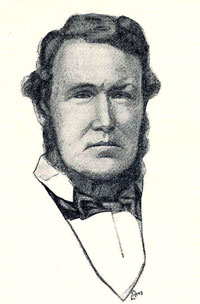
Major Robert S. Neighbors, special agent
for the Indians of Texas, was a loyal and courageous friend
and protector of Caddo rights and safety. From Walter Prescott
Webb, 1935, The Texas Rangers: A Century of Frontier Defense.
|
Following the signing of the 1846 treaty, a
delegation of the chiefs was taken to Washington D. C. Major
Robert S. Neighbors, newly appointed special agent for the
Indians of Texas accompanied them. The long and tiring trip
was meant to impress the Indian leaders with living conditions
in the United States and the power of its government. As a
bonus, Major Neighbors gave the chiefs the horses they rode,
on arrival back in Texas. José Maria brought home a
document signed by President James L. Polk that was proudly
protected through several generations.
The Bitter Years 1847-1853
The Anadarko village was then sixteen miles
west of the present town of Hillsboro. A second Anadarko-Hainai
village was not far off away. José Maria had formed
friendships with good Texas families all along the Brazos
River and often visited their homes. Another kind of Texan,
a troublemaker with a bad reputation, accused José's
people of stealing hogs and threatened him with a gun. He
then tried to raise a force to kill José Maria's entire
band. White friends told the chief it would be wise to move.
So Anadarkos once more left homes and fields behind, moving
to a place on the Navasota River in Limestone County.
It was not their last forced move. Two years
later the Anadarko, Caddo, and Hainai were living in Palo
Pinto County. Surveyors were seen all about and they had learned,
wherever there were men with measuring sticks and chains,
settlers soon followed.
In 1848, Texas Rangers killed a sixteen-year-old
nephew of Caddo chief Ha-de-bah. They had no excuse for doing
so. They knew the young man. He had supplied their post with
game and gave them no cause to kill him. José Maria
had a hard time controlling his people's anger but managed
to convince them they should keep the treaty and let the agent
handle justice. Major Neighbors recommended yet another move.
José Maria again relocated his people. This time farther
northwest near a well known landmark called Comanche peak.
A Report of the Commissioner of Indian Affairs
in 1849 said that José Maria was the leader of twelve
hundred people. Caddos who had gone to Mexico after leaving
Louisiana had returned during the summer of 1844 and fragments
of some other tribes had joined under José Maria's
leadership. The report also stated that the Anadarko and Hainai
as well as the Caddo had migrated from Louisiana. Texans in
1849 commonly chose to forget, or did not know, that the Anadarko
and Hainai had lived in northeast Texas for hundreds upon
hundreds of years before Americans arrived. Major Neighbors'
census recorded 1,400 Caddos, Hainai, and Anadarkos with 280
warriors.
Forced to abandoned field after field, often
before they could harvest crops, Anadarkos & Hainais living
near Comanche Peak made only enough corn to last about 4 months
in 1853. Caddos near the junction of Clear Fork with Salt
Fork on the Brazos made so little corn it was consumed in
roasting ears. The Caddo Chief was dead. Some of the young
men had taken to whiskey. Game was scarce for all. The treaties
signed in good faith and earnestly kept had failed to relieve
their uncertain lives.
End and Beginning of Homelessness 1854-1859
Early in 1854, the Texas legislature reacted
to pressure by citizens demanding a protective line between
themselves and the Indians. An act providing for Indian reserves
gave the federal government authority to select twelve leagues
of land for the reservations. A line of military posts was
intended to separate Indian range from white settlements.
Captain Randolph B. Marcy and Major Neighbors were appointed
to locate and survey lands. They called the chiefs together
for a council.
José Maria was now sixty years old. He
had attended too many councils with too many white men to
have faith that this one would have truer meaning than the
others. In this council his words reflected many crushed hopes.
|
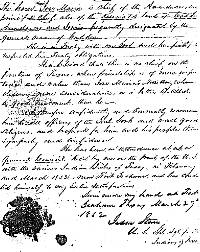
"It is believed that there is no chief
on the frontier of Texas, when friendship is of most importance
and value than Jose Maria--nor any to deserving more consideration,
or is better entitled to good treatment than he." Jesse
Stem, US Special Indian Agent for the Indians of Texas 1852
|
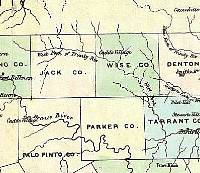
Area where Caddo villages stood during the "bitter years
1847-1853." The map was published in 1857, but the two
Caddo village locations shown are those prior to 1854. Galveston,
Houston, and Henderson Railroad map. Courtesy David Rumsey Map
Collection. |
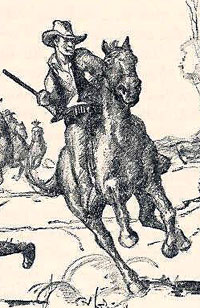
In 1848, Texas Rangers killed a sixteen-year-old
nephew of Caddo chief Ha-de-bah. They had no excuse for doing
so. They knew the young man. He had supplied their post with
game and gave them no cause to kill him. Drawing from Walter
Prescott Webb, 1935, Texas Rangers: A Century of Frontier
Defense.
|
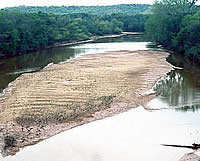
The sandy, salty, and intermittent Salt
(or Main) Fork of the Brazos not far above its confluence
with the deep Clear Fork. Caddos lived very near here in the
early 1850s in great uncertainty. Photo by Susan Dial.
|
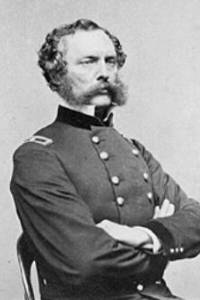
Captain Randolf Barnes Marcy located and mapped the lands
that became the Brazos Reservation. (Shown here as a Union
General in the Civil War.)
|
|
| |
I know our Great Father has power to do
with us as he pleases; we have been driven from our homes
several times by the whites, and all we want is a permanent
location, where we shall be free from further molestation.
. . .Heretofore we have had our enemies, the whites on one
side, and the Comanches on the other, and of the two evils,
we prefer the former, as they allow us to eat what we raise,
whilst the Comanches take everything, and if we are to be
killed, we should much rather die with full bellies; we would
therefore prefer taking our chances on the Brazos, where we
can be near the whites.
|
|
|
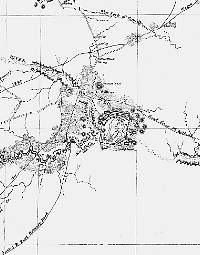
"Marcy Map" of 1854 "Map
of the Country upon Brazos and Big Wichita Rivers Explored
in 1854, Embracing the Lands Appropriated by the State
of Texas for the Use of Indians."
|
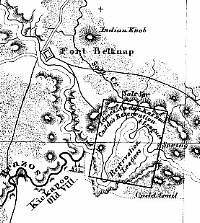
Detail of original Marcy Map showing area where Brazos
Reservation was established. |
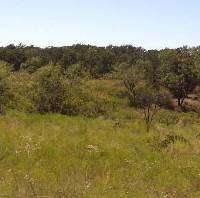
The mesquite- flat country around
the Brazos Reserve was a very different environment
from the Caddo Homeland: drier with shallow and less
fertile soils. Photo by Susan Dial.
|
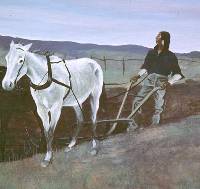
This painting by Nola Davis based
on Remmington's "Twilight of the Indian" brings
to mind the Caddos' days on the Brazos Reserve. Courtesy
Texas Parks and Wildlife.
|
|
A
reserve of 37,152 acres, for the Anadarko, Caddo, Waco, Kichai,
Delaware, Twakoni, and Tonkowa, was commonly called the Brazos
Reserve. It was situated on the main branch of the Brazos a
few miles below Fort Belknap in present Young County. A separate
reservation for Comanches was called the Upper Reserve.
The Caddo, Hainai and Anadarko gathered in March
1855, eager to break the tough prairie grass sod and plant
fields in ground they could call their own. It was a dry spring—no
rain for nine months. Four hundred acres were planted but
the seeds, dropped late in dry earth, did not yield enough
to make the effort worth while. Two-hundred-five Anadarkos
(Hainai were counted with the Anadarkos) and 188 Caddos settled
in villages next to dried-up fields.
Drought and grasshoppers spoiled the next two crops as well.
But the following year forecast a good life in villages with
traditional grass houses, neat cabins, and gardens full of
vegetables and melons. The chiefs and the agents worked together
to organize law and order. A government farmer lived at the
agency in the middle of the reserve and worked with the people
to develop their fields and stock. A resident blacksmith took
care of tools and weapons.
The Caddos built seven good log houses and
had 130 acres in corn, 20 in wheat in 1857. The Anadarkos
built ten log houses and had 115 acres of corn and 20 acres
of wheat. Particular attention was given to raising stock
and the number of horses, cattle and hogs steadily increased.
The women milked and made butter. There were few deaths and,
for the first time in many years, children were thriving.
Finally, in 1858, a schoolhouse was built and the teacher
soon had sixty pupils.
Outside the Reserve, the landscape was changing. When Neighbors
and Marcy surveyed boundaries for the reserves, a wide stretch
of mesquite-dotted country lay between Texas settlers and
the Indians. But in less than three years, while the Caddos,
Anadarkos, and Hainais built and planted, a boom of new settlers
came to Fort Belknap and Young County. Complaints that the
federal government provided too little protection rose with
the increasing white population. Hostile Indians, mostly from
north of Red River, raided Texas settlements. They made an
easily followed trail to the Brazos Reserve and then scattered
so that no trail was visible above.
Small groups of self-appointed protectors ready
to believe the worst about any Indian, concluded that all
their troubles were caused by reserve Indians. A leading troublemaker
was John R. Baylor who had been dismissed as the first agent
for the Comanches on the Upper Reserve. His inflammatory remarks
in public letters and mass meetings of citizens excited prejudices
and roused emotions.
The year the schoolhouse was built on the Brazos
Reserve, Texas Governor H. R. Runnels authorized J. S. Ford
to organize a hundred Texas Rangers. Ford brought his Rangers
to the Reserve to enlisted the tribes' help in a war against
the Comanches across Red River. The chief's called in to council
willingly agreed to send about one hundred warriors. They,
too, had suffered the loss of great numbers of livestock to
raiders from across the River and had been subjected to unjust
blame for depredations those Indians had committed upon white
settlers.
Ford directed an attack on Comanches camped
near the Canadian River on May 12. A running battle covering
over six miles began about seven in the morning and lasted
until Ford declared a victory about two in the afternoon.
He gave the Indian captains his highest praise saying, "They
behaved under fire in a gallant and soldier-like manner and
I think they have fully vindicated their right to be recognized
as Texas Rangers of the old stamp."
That fall, 1858, 125 Anadarko, Caddo, and other
Brazos reserve warriors again cooperated in successful campaign
against the northern Comanches. This time they rode in support
of 400 U.S. cavalry led by Major Earl Van Dorn. The Major
asked them to accompany him again on his spring campaign.
They planned to do so, but for now their horses needed rest
and fattening.
Agent Ross gave Tom, a Choctaw married to an
Anadarko woman, permission to take his wife, some of his grandchildren,
and other family connections a few miles below the reserve
where there was good grass for grazing. All together there
were twenty-seven people in the party—eight men, eight
women, and eleven children. They set up five camps above Golconda,
in Palo Pinto county. Late fall eased into an early winter
and hunting season. Several white men came to ask Tom's family
to go with them on a bear hunt. The family agreed and moved
camp to the edge of a small creek about 15 miles below the
reservation. Near daylight, before anyone was awake, gunshots
pierced their tents. Choctaw Tom's wife, another Anadarko
woman, three Anadarko men, a Caddo man and Caddo woman were
killed. Six died instantly on the beds where they slept; the
seventh was able to reach his gun and crawl through the tent
flap before he died. José Maria's nephew, Little John
who had served with Van Dorn, was one of the young men killed.
A thumb was shot off the hand of Tom's daughter. Another woman
and three men had severe wounds. Eight children were injured,
three seriously. The name's of the men who participated in
the massacre were known. They made no secret of their identities.
People who lived near the camp left their homes.
Agent Ross was away so it was left to J. J. Strum, the government
farmer for the Brazos Reserve, to explain that the settlers
were afraid of blame and retaliation. José Maria and
the Caddo chief, Tinah, said tell them "We are not wild
Indians and will not harm the innocent." They said Strum
should send someone to tell those settlers, most of whom were
friends, to return to their homes and take care of their farms.
The Caddo and Anadarko did not blame them—they had been
told that the men who killed members of their families would
be caught and punished according to the white man's law, and
that was the way it should be.
That is not the way it was. There were no arrests.
At an official examination of the murders that took place
in Waco, the grand jury described the Brazos reserve as a
nuisance. Stating that the Indians there were doing all the
mischief they concluded, "It is now the prevailing sentiment
that we must abandon our homes and take up arms against the
reserved Indians." Instead of charging the admitted murderers,
the jury found José Maria guilty of stealing a mule.
Near the end of February, Comanches stole 80
horses from the Caddo—about the last of some five hundred
head they and the Anadarko had three months earlier. In May
a Caddo Indian named Fox, was brutally killed while carrying
a official dispatches from Agent S.A. Blain at Fort Arbuckle
in Indian Territory to Agent Ross at the Brazos Reserve. Agents
were accustomed to expressing dispatches between reservations
by reliable members. They had known Fox since boyhood, he
had done good service in Ford's and Major Van Dorn's fights.
An army officer accompanied by a party of Indians from the
reservation went to Jacksboro in search the men who murdered
Fox. This incident was used by John R. Baylor to spark an
attack on the reserve.
On the morning of May 23, 1859, Baylor led a
force of two hundred fifty men onto the Brazos Reserve. An
infantry company from Fort Belknap reinforced a guard that
had been posted at the agency. Baylor and his company drew
their mounts up in a single line within 600 yards of the agency.
He told the officer sent to meet him that he had come to fight
Indians, not whites, but if the troops fired on his men, they
would fight back. The Captain in command said his orders were
to protect the Indians on this reserve from the attacks of
armed bands of citizens and he would do so to the best of
his ability. Baylor backed off and set up camp outside the
border of the Reserve. At the same time he declared that the
warning did not alter his determination to destroy the Indians.
Neighbors urged the Office of Indian Affairs
to authorize immediate removal of the tribes to a temporary
location north of the Red River at Fort Arbuckle. Instructions
were finally written on June 11—pack up and move.
The Removal
The thermometer reading on the Brazos Reserve
for the past month had averaged 106 degrees from midmorning
until five in the evening. The gauge was no different on the
first day of August when the families of the Caddo, Anadarko,
Hainai and associated bands left their houses, gardens, almost
all their stock and all possessions they could not carry.
The whereabouts of Baylor and his mob was not known, but it
was possible that they would try to carry out their threat
to kill all the Indians as soon as they were off the Brazos
Reserve. Two companies of cavalry and one of infantry provided
a protective escort. Wagons carried military provisions for
five months. The very old and infirm rode, the very young
and small were carried, most walked the arid two hundred mile
trail that ended on the bank of the Washita River near present
Anadarko.
|
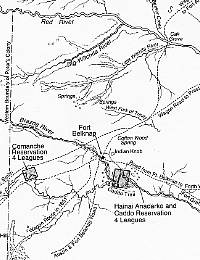
Redrawn version of the Marcy Map of 1854 showing the Brazos
Reservation. From Carter, 1995. |
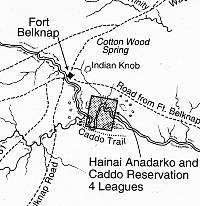
Detail of redrawn version of Marcy
Map of 1854. From Carter, 1995.
|
|
Brazos Indian Reservation School
Operated for Indian children living on Brazos Reservation,
a 37,000-acre refuge created by state in 1854. Here
over 1,000 Anadarko, Caddo, Delaware, Ioni, Shawnee,
Tawakoni, and Tonkawa people lived, farming and acting
as U.S. Army Scouts. Despite racial strife outside reserve,
teacher Z. E. Coombes (1833-95) reported unusual good
will and harmony in classroom. Subjects taught were
English, spelling, writing, and arithmetic. From 34
to 60 students were enrolled. School closed when Indians
were moved north in 1859.
Texas Historical Marker
|
| |
|
|
| |
Esther Hoag Hornovich:
He often told us that there was different
bands of Caddos at the point of—course of the Red River.
He said they were called Kahadoches—they were up around
in there, a large group of them. Several villages, but it
see like he said towns, I do not know the exact words in Caddo,
but he said there were some Hanai groups, and then along the
Sabine River . . . . there were bands living along the Angelina
River and Colorado River and some at the point of Sabine around
in that area and along the limestone caves and around Santa
Marcus. . .And that was told him by Grandmother. . .He said
all the bands including a few of the tribes that were with
the Caddos . . . were brought to Washita Valley . . . and
he said there was others also from the east that had to come
later. . .I mean now eastern Oklahoma and in that vicinity—Choctaw
country. The Whitebead family and some others—The Nedarkos
[Nadacos, Anadarkos] were not living below Belknap
before that time. They were living in east Texas somewhere
or Louisiana. . . that was their beloved home and when they
[Caddos] made this treaty and they wanted them to move on,
that they were paid and later on they moved away from there
to west from there towards the Angelina River with other tribes
that were already there of their people. . .I do not know how
the map is. Anyway it's close to this Angelina River. . .all
I remember of the ones he named was mainly his own people
and the Nadaco and there was the Iona [Hainai]
Band which was similar to the Nadaco . . . it seems that the
white people in East Texas wanted the fertile land down there
and they wanted them removed so when they were removed and
given certain tract of land there [the Brazos Reserve] for
their permanent establishment but it seems later on in a few
years, at least four years, they had this trouble with Baylor
and his men. . . . he did not remember anything because he
was a small baby when they moved there [Oklahoma]. . . the
soldiers brought them and they kept the old folks, old ladies
and small children in a wagon. I did not pay attention to haw
many they had. My Grandmother, she walked all the way and
her sisters, and her daughter, my oldest aunt, took turns
carrying my daddy because he was too heavy.
Esther Hoag Hornovich,
daughter of Enoch Hoag,
Jose Maria's son
|
|

|